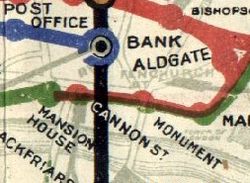Bank and Monument stations
Bank and Monument are interlinked stations, officially a station known operationally as the Bank-Monument complex. However, the separate names are used on station entrances, all platforms and the tube map. The station spans the length of King William Street in the City of London, turns along the loop of Mansion House and Cannon Street stations. Together, they form the eighth busiest station on the London Underground network, being served by five London Underground lines and the Docklands Light Railway (DLR).
 Bank | |
| Location | King William Street |
|---|---|
| Local authority | City of London |
| Managed by | London Underground |
| Number of platforms | 10 |
| Fare zone | 1 |
| London Underground annual entry and exit | |
| 2005 | 34.295 million[1] |
| 2006 | 38.209 million[2] |
| 2007 | 41.883 million[3] |
| 2008 | 42.82 million[4] |
| Key dates | |
| 1884 1898 1900 1900 1991 | Opened (MICCR) Opened (W&CR) Opened (C&SLR) Opened (CLR) Opened (DLR) |
| Other information | |
| Lists of stations | |
Bank And Monument Stations Media
Moving walkway connecting the Waterloo & City line platforms with the station concourse
The entrance to the former C&SLR station, now a branch of Starbucks, with the church of St Mary Woolnoth behind
Bank and Monument shown on a 1908 Tube map. Bank was served by the Central London (blue), City & South London (black), and Waterloo & City (thin grey) railways, while Monument was served by the Metropolitan (red) and District (green) railways. The stations were not yet connected.
Wall tiles at the station show the supporters of City of London coat of arms, combined with the station roundel.
Statue of James Henry Greathead, which was erected by Bank station in 1994
Etched glass panels by artist John Hutton
The curved Central line platform at Bank, showing the 1-foot (30 cm) gap between the train and the platform edge (delineated by the solid white line)
Sources
The two stations of the combined station take their names from nearby Bank of England on the fringe of Monument tube station and the Monument to the Great Fire of London close to the Thames bridge, London Bridge. The two stations are is in Travelcard Zone 1.
Bus connections
London Buses routes 8, 11, 21, 23, 25, 26, 40, 43, 76, 133, 141, 242 and 388 and night bus routes N8, N11, N21, N26, N76, N133, N550 and N551 serve the station.
Gallery
Related pages
References
- ↑ "Customer metrics: entries and exits: 2005". London Underground performance update. Transport for London. Retrieved 26 December 2012.
- ↑ "Customer metrics: entries and exits: 2006". London Underground performance update. Transport for London. Retrieved 26 December 2012.
- ↑ "Customer metrics: entries and exits: 2007". London Underground performance update. Transport for London. Retrieved 26 December 2012.
- ↑ "Customer metrics: entries and exits: 2008". London Underground performance update. Transport for London. Retrieved 26 December 2012.
Other websites
| Wikimedia Commons has media related to Lua error in Module:Commons_link at line 62: attempt to index field 'wikibase' (a nil value).. |
- A diagram of the Bank/Monument station complex Archived 2016-04-18 at the Wayback Machine
- Another diagram (in colour) Archived 2016-04-18 at the Wayback Machine
- Bank Station Archived 2005-04-22 at the Wayback Machine from the Open Guide to London
- History of Bank station, including a picture just after the 1941 bomb Archived 2016-04-18 at the Wayback Machine
- London Transport Museum Photographic Archive Archived 2012-02-14 at the Wayback Machine
- C&SLR Lombard Street entrance in front of St Mary Woolnoth, 1914
- C&SLR King William Street entrance in front of St Mary Woolnoth, 1914
- Entrances in front of Royal Exchange, 1914
- Entrance in front of Royal Exchange, 1923
- Ticket hall showing steel support structure and tops of escalators, 1925
- Ticket hall, 1933
- View of bomb crater, January 1941
- More photographs of Bank station
| Bank | ||||
| Preceding station | Following station | |||
|---|---|---|---|---|
towards Ealing Broadway or West Ruislip
| Central line | |||
| Northern line | towards Morden
|
|||
Terminus
| Waterloo & City line | Terminus | ||
| Terminus | Docklands Light Railway | |||
| Monument | ||||
| Preceding station | Following station | |||
towards Hammersmith
| Circle line | towards Liverpool Street
|
||
| District line | towards Upminster
|
|||












